The leaves, tender shoots, flowers, pods and seeds of all these trees and shrubs can be fed to ruminants (cattle, buffaloes, sheep and goats) and to non-ruminants (pigs, rabbits and poultry). They contain high levels of protein and some important minerals like phosphorus (P) which make your animals grow rapidly. (See table.)
Average percentage of dry-matter content
| (%) | Protein | P | Fibre |
| Leucaena a | 22 | 0.12 | 20 |
| Gliricidia a | 23 | 0.20 | 21 |
| Mesquite b | 36/14 | 0.20 | 6/28 |
| Pigeon pea a | 23 | 0.20 | 30 |
a Green leaves and shoots.
b Seeds/Pods.
They also contain high levels of fibre (see table). This rapidly fills the stomachs of pigs and chickens, so these tree fodders are more suitable for cattle, sheep and goats than for non-ruminant animals.
Some tree fodders contain toxic compounds and so you should not feed a lot of this type of fodder to any animal, including cattle, sheep and goats.
How much tree fodder can you feed to your livestock, and should you feed them green, fresh or dried?
The easiest way to feed the fodder is to let your cattle, sheep, goats or camels browse directly on trees in the range, in fallow land or in your backyard, if the trees are not too tall.
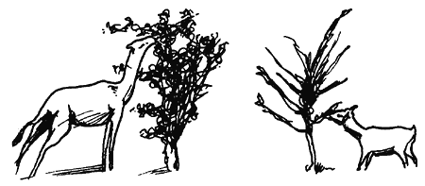
If the trees are too tall, you may have to cut the branches
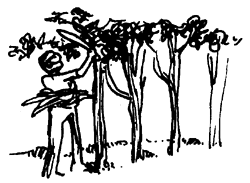
and carry them to your animals to eat
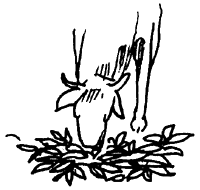 | 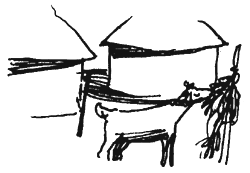 |
| in the field, | in your backyard, |
or in the stall.
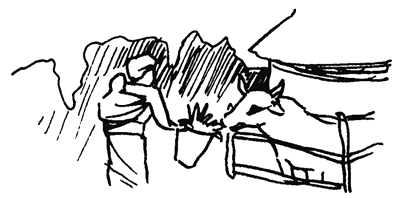
In this way, your animals will eat fresh leaves and small stems. Goats will sometimes eat the bark of large stems and this is also good for them.
Another way is to feed dry forage. Cut it and dry it in the sun for a few days,
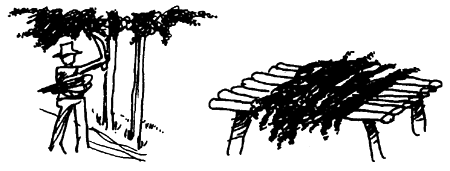
then store it for feeding later on.

It is in this dried form that you should feed the fodder to pigs and chickens. After sun-drying, crush or grind the leaves and small stems to make a leafmeal which you can feed directly or mix with other feeds.

How much tree fodder should be fed to livestock? Many fodder trees such as Gliricidia and Sesbania contain very little or no toxic compounds. You can therefore feed a lot to ruminants, as much as they will eat, particularly during the dry season when there is no other green feed available.
Other trees such as Leucaena contain toxic compounds that can harm your animals, including ruminants, pigs and chickens. You therefore need to mix them with other feeds to dilute the toxic compounds.
For example, you can feed a mixture of Leucaena and Gliricidia to sheep and goats, making sure that Leucaena is not more than 30 to 40 percent of the mixture.
You can also mix one part of dry Leucaena with one and a half or two parts of crop residues such as maize bran or stovers, but always provide your animals with salt blocks when feeding them Leucaena.
If you cannot mix the fodder with other feeds because, for example, your animals go out to eat crop residues, grass, hay or straw in the field, offer them an amount of fodder equal to 2 percent of their body weight to supplement the crop residue, grass or hay.
For pigs, rabbits and chickens, the amount you can feed is even smaller. In any case do not exceed 10 to 15 percent of the diet for pigs, laying hens and rabbits, and 5 to 10 percent for growing chickens.
Other parts of fodder trees that you can feed to livestock are the pods and seeds of trees such as pigeon pea and mesquite.

You should not feed such seeds raw or fresh; they should be dried, cracked or ground into flour before you feed them. If they are not cracked or ground before you feed them, the animal may not digest them well and the seeds will just pass out in the faeces with no real benefit to the animal.
Seeds of trees such as pigeon pea and Prosopis juliflora also contain some harmful substances that can be destroyed by heating. You need to treat the seeds with heat to destroy these substances before feeding your animals.
You can do this by soaking the seeds overnight in water. The next day, drain the water and add fresh water, then bring it to the boil, and let it boil for five minutes. Let the water cool down, drain it and dry the seeds in the sun.
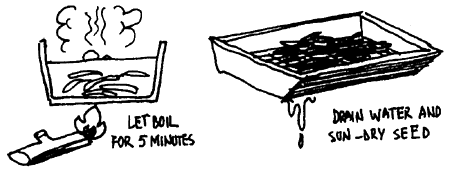
You can also just soak the seeds overnight in cold water and dry them in the sun the following day. These methods are long and difficult.
So, if possible, buy the pod flour from factories where it has been well processed and mix it with other ingredients to feed your animals.
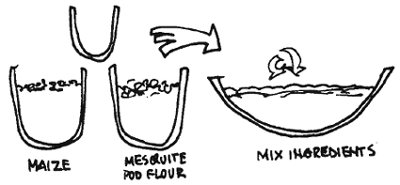
Remember to be cautious, although you can even feed fodder from these trees and shrubs to ruminants as the only feed (100 percent), but mix at least two, or more, sorts of fodder. For example, mix one part of Leucaena with three parts of Gliricidia. Sheep and goats like this mixture. You can also mix one part (40 percent) of the tree fodder with one and a half parts (60 percent) of grasses, hay straw or crop residues (fresh, green or dried).
For non-ruminants such as pigs and chickens, dry and grind the fodder, and feed only between 5 to 15 percent of leaves and stems, and no more than 40 percent of pods and seeds in the diet.
However, in any case, remember that the feeding behaviour of your animals fed fodder tree-based diets is a good indicator of what is to be done: to reduce or to change the proportion of fodder from trees in their diets.